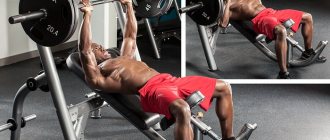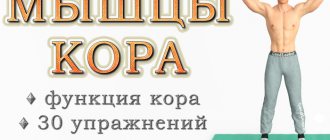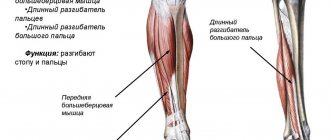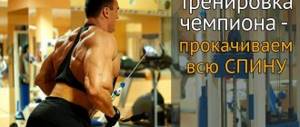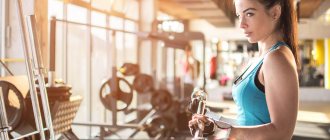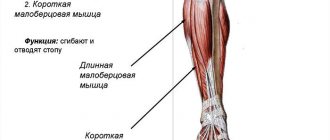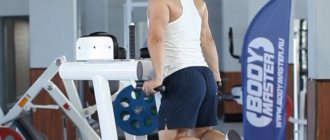Without pumped up and strong legs it is impossible to imagine an attractive athletic figure of a man.
When organizing workouts at home, it is important to include in the complex exercises that allow you to work all muscle groups of the lower extremities.
Exercises should be regular, including moderate strength loads. Working out the leg muscles with properly organized exercises usually takes 4-8 weeks.
Training at home: rules, recommendations, common mistakes
Working on the leg muscles is important for all men, regardless of their age, lifestyle and level of physical fitness.
Why is it important to have trained muscles of the lower extremities:
- the level of physical endurance increases;
- the correct position of the pelvis is created;
- provides prevention of varicose veins and thrombophlebitis;
- metabolism accelerates, fat deposits are burned faster.
During leg workouts, the muscles of the buttocks and thighs are used. You can organize at home without visiting the gym.
Important! First of all, the loads must be regular. It is optimal to devote 3-4 days a week to leg fitness, maintaining equal intervals between sessions. The recommended duration of one lesson is 40 minutes.
To choose the right leg exercises for men, performed at home, you need to know what the muscles of the lower extremities are. It includes a large number of large, medium and small muscles that have a close relationship with each other.
A men's leg workout should include fitness techniques that work the following muscle groups:
- quadriceps (front of thighs);
- the hamstring muscles located under the buttocks;
- buttock muscles;
- soleus and gastrocnemius muscles.
The muscles of the legs are of the slow type. She quickly adapts to the monotonous loads associated with running, standing and walking. To gain sculpted muscles in the legs, they need to be subjected to strength loads, which help to use all the muscles of the limbs during one workout.
If a man has excess fat deposits in the thighs, calves and buttocks, then just doing strength exercises will not get rid of excess weight. You can pump up noticeable muscles in the lower extremities only after losing weight.
Important! Proper nutrition with a limited calorie diet and the exclusion of saturated fats and simple carbohydrates will help eliminate excess fat. Cardio exercises, which you need to devote about 30 minutes daily, will help speed up your metabolism, thereby starting the fat burning process.
Basic recommendations for organizing training at home:
- Before each session, you need a five-minute warm-up to warm up your muscles and tendons. Ignoring fitness techniques to prepare muscles for exercise significantly increases the risk of injury.
- The complex should consist of fitness techniques for pumping all muscle groups of the lower extremities.
- provided regular and proper training is possible in at least a month. There are no sets of fitness techniques that allow you to achieve the desired result in a few days.
- A diet that includes protein nutrition helps to increase the effectiveness of exercise. Sufficient amounts of proteins help build muscle.
- Alternating strength training with cardio exercises will help normalize metabolism and increase physical endurance.
Typical mistakes of men who intend to pump up the muscle tissue of the lower extremities:
- the desire to achieve results within a few weeks, focusing on grueling training;
- daily classes seven days a week;
- reduction of the knee joints when performing squats of any degree of difficulty;
- hunched back when performing lunges and squats.
Correctly organized training allows you to avoid problems with joints and tendons, as well as harmoniously pump up the muscles of the lower extremities.
Anatomy of leg muscles
To choose the right exercises, we must understand exactly which muscles are working. Let's look at the anatomy of the leg muscles and find the best ways to pump them up.
Let's start with the largest muscle group in humans - the muscles of the lower extremities. In this material I will try to briefly, but in sufficient detail, analyze all the questions regarding the structure and anatomy of the leg muscles. I will also give you the best exercises for their development.
No one argues that reading such topics is very tedious. It’s much more interesting to look at publications from the series “How to enlarge your butt” or “How to pump up your abs to a six-pack.” But it is impossible to grow big buttocks without pumping up your legs, without clearly understanding which muscle works in a particular movement.
So get ready to read carefully. At the end, a pleasant bonus awaits you - a selection of the best exercises for developing the muscles of the legs and buttocks.
Effective loads for the calf muscles and thighs
Each fitness technique from the complex should ensure a full pumping of the leg muscles.
The table shows the best exercises for different muscle groups of the lower extremities for men:
| Muscles | Exercises | Execution technique |
| Calves and soleus muscles | Calf raises | The legs are placed together, and the hands are on the belt. As you exhale, tense your calves and lift them onto your toes, and as you inhale, lower your feet to the floor. It is recommended to do 20 rhythmic repetitions in one approach. |
| Pulling your legs towards your buttocks (you will need a dumbbell weighing up to 2 kg) | You need to lie on your stomach on the floor. A dumbbell is held between the feet. As you exhale, bend the limbs at the knee joints, pulling the feet with the load towards the buttocks. It is optimal to perform 15 repetitions in 2-3 approaches. | |
| Muscles of the thigh and buttocks | Squats | Place your hands behind your head and straighten your posture as much as possible. The legs stand at the same width as the shoulders. The feet and knee joints must be at the same level. As you exhale, spread your knees and squat, bringing your pelvis as close to the floor as possible. The foot rests completely on the floor. As you inhale, return to the starting position. It is optimal to do at least 15 repetitions in 3 sets. You can complicate the fitness routine with dumbbells. |
| Scissors | Take the same position as for performing lunges. As you exhale, make a high jump, changing the position of your limbs in the air. During landing, they rely on the limb set back. The landing should be soft. This exercise is repeated 15-20 times. | |
| Spring lunges with dumbbells | You need to stand up straight with your feet shoulder-width apart. The knee joint of the leg extended forward is bent at a right angle. The second leg stands behind in line with the other limb. Take dumbbells in your hands and straighten your limbs “at the seams.” As you exhale, strain your thigh and squat down, lowering the knee of the leg laid back to the floor. As you inhale, you need to get into the starting position. Do 15 repetitions for each limb. | |
| Gluteal bridge | Lie on your back and place your arms along your body. With your feet fully on the floor, place them shoulder-width apart, bending your limbs at the knee joints. As you exhale, tensing the muscles of your shoulder blades and calves, lift your buttocks and hold them at the peak point for several seconds. As you inhale, lower the sacrum to the floor. The fitness technique is repeated 15-20 times in 2-3 approaches. The advantage of this exercise is that it also puts stress on the calf muscles. |
On days free from training, you can pay attention to half-hour cardio exercises, during which the muscles of the lower extremities are involved. In the morning, you can organize a run at a moderate pace. If this is not possible, then jogging is replaced by walking at a fast pace. Cycling is also the best option.
Muscles of the lower extremities
Home » Human structure » Musculoskeletal system » Muscles of the lower extremities
The lower limbs of a person withstand enormous loads, because they have to perform the functions of support and movement. Because of this, these muscles are the most powerful muscles in humans. For prevention, take Transfer Factor. The muscles of the lower extremities, like the muscles of the upper extremities, are divided into groups, depending on topographical and functional features. The muscles of the pelvic girdle and the muscles of the free part of the lower limb - the thigh, lower leg and foot - are distinguished. However, an absolute analogy cannot be drawn between the muscles of the upper and lower extremities due to differences in their structure. If a person’s shoulder blade and collarbone have great freedom of movement, then the pelvic girdle is firmly, almost motionlessly connected to the spine at the sacroiliac joint.
The pelvic muscles provide movement of the legs at the hip joint, as well as the spine. The muscles of the pelvic girdle are divided into two groups - external and internal. The group of external pelvic muscles includes the gluteus maximus, medius and minimus, quadratus femoris, tensor fascia lata, superior and inferior gemellus muscles and the external locking muscle. The group of internal muscles is formed by the iliopsoas muscle, the obturator internal muscle and the piriformis muscle.
The thigh muscles are located around the thigh bone and are divided into three groups: anterior, posterior and medial. The thigh muscles are involved in holding the human body in an upright position, but their main function is movement. Like the pelvic muscles, the thigh muscles reach their maximum development in connection with human upright posture. Having greater mass and length, the thigh muscles develop greater force, acting on the hip joint and knee joint.
The muscles of the lower leg are well developed, which can be explained by their functions associated with human upright posture. They have an extensive origin on the bones, intermuscular septa and fascia and act on the knee, ankle and foot joints. These muscles are responsible for dorsiflexion and plantar extension of the foot, as well as the support functions of the foot and its orientation. The lower leg muscles are divided into anterior, lateral and posterior groups. The anterior group of muscles mainly includes the extensors of the foot, the lateral group includes the flexors and pronators of the foot, and the posterior group includes the flexors and supinators of the foot.
The muscles of the foot, due to human upright posture, have a special purpose. Their main function is to provide stability in various positions of the foot, flexion, extension and abduction of the toes. The muscles of the foot include a group of muscles on the dorsum of the foot (extensors) and a group of muscles on the plantar surface of the foot (flexors).
Rules for organizing training
An exercise with an emphasis on the muscles of the legs begins with a warm-up. Its duration is 5-10 minutes, and it includes light exercises such as jumping, running in place, and circular rotations with toes placed on the floor.
The main training begins by performing fitness techniques to work out the lower part of the legs - the calf and soleus muscles. It is optimal to perform 2 effective exercises for these muscles.
At the next stage, lunges and squats are performed, the number of repetitions and approaches of which depends on the general athletic training of the man.
In the middle of the class, you can pay attention to cardio training, for example, jumping rope. You can finish the training with an exercise performed in a lying position. The best option in this case would be a gluteal bridge.
The total duration of the training is 30-40 minutes.
The structure of the muscles of the human legs
Actually, let's move on to the main thing. The human legs represent 5 muscle groups:
- anterior thigh;
- back of the thigh;
- inner thigh;
- calf muscles;
- buttocks.
The general picture of the leg muscles looks like this:
Now let's look at each group separately. Let's find out what functions this or that muscle performs. Let's learn how to control it during the exercise. We will also learn the best ways to “pump up” each muscle group.
Muscles of the anterior thigh
The exact name is the quadriceps femoris muscle (or quadriceps). The strongest muscle of the lower extremities. It occupies the entire front surface of the thigh and part of the outer one.
The quadriceps consists of:
- broad lateral;
- medial broad;
- intermediate wide;
- rectus muscle.
In the picture version it looks like this:
The quadriceps is the main muscle of the thigh, but not the only one. At the top of the legs are the tensor fasciae lata and the sartorius muscle, which runs diagonally from the outside of the hip joint to the inside of the knee joint.
Interestingly, the sartorius muscle is not involved in extending the leg at the knee, but is related to the quadriceps.
The main functions of the muscles of the anterior thigh group:
- shin extension (leg extension at the knee joint);
- hip flexion (bringing the thigh closer to the stomach);
- shin flexion (bending the leg at the knee);
- abduction and external rotation of the hip.
Hamstring muscles
The hamstring muscles are the name given to the muscles on the back of the thigh. Anatomically, they are represented by 3 separate muscles:
- biceps femoris (biceps muscle);
- semitendinosus;
- semimembranous.
The photo below shows the structure of the muscles of the back of the thigh.
The main functions of the muscles of the posterior thigh group:
- shin flexion (bending the leg at the knee joint);
- hip extension (pulling the hip back or straightening the torso from a tilted position);
- maintaining body balance.
Muscles of the inner thigh
These muscles are usually called adductors, since their main function is to bring the femur inward. Anatomically, the inner thigh is represented by 5 small muscles:
- thin;
- comb;
- long adductor;
- adductor brevis;
- adductus magnus
I give a clear example in the photo.
Functions of the adductor muscles of the thigh:
- hip adduction;
- shin flexion (bends the leg at the knee);
- hip flexion (pulls the thigh toward the body);
- turning the shin inward;
- external rotation of the hip.
On topic: Leg stretching exercises for cross splits
Calf muscles
The main volume of the lower leg is created by the gastrocnemius and soleus muscles. They work together. The anatomical atlas of the lower leg is represented by the following muscles:
- gastrocnemius (biceps muscle);
- soleus;
- flexor digitorum longus;
- flexor pollicis longus;
- extensor digitorum longus;
- extensor pollicis longus;
- popliteus muscle;
- anterior tibial;
- long fibula;
- short fibula;
- plantar
In a visual example it looks like this:
- Muscles of the posterior leg group
- Muscles of the anterior group of the leg
Main functions of the lower leg muscles:
- flexion of the foot and ankle;
- shin rotation;
- extension and supination of the foot.
Gluteal muscles
The buttocks are the most frequently trained area among the female half of the gym. Anatomically they are represented by three muscles:
In the picture version, our “fifth point” looks like this.
Functions of the buttock muscles:
- abduction of the hip back;
- hip abduction to the side;
- movement of the hip joint (torso straightening).
Now that we've sorted out the theory, let's move on to the second part of the article.
The best complexes: 3 options
One complex includes 3-4 exercises performed in 3 approaches. Each fitness move takes 3-4 minutes to complete. A mandatory warm-up period of at least 5 minutes is given at the beginning of the lesson. The same amount of time is allocated for 1 cardio exercise.
First complex:
- warm-up – 5 minutes;
- raising on toes while sitting on a chair with weights on the front surface of the thigh - 15 repetitions in 3 sets;
- squats with dumbbells weighing 1 kg in each hand – 10 repetitions in 3-4 sets;
- scissors with jumping – 20 repetitions in 3 sets;
- cardio – 3 minutes;
- gluteal bridge – 15 repetitions in 3 sets.
Second complex:
- warm-up – 5 minutes;
- classic calf raises in a standing position - 20 repetitions in 3 sets;
- lunges with dumbbells – 10 repetitions in 4 sets;
- squats without dumbbells - 15 repetitions in 3 sets;
- cardio – complicated “bicycle” exercise (15 repetitions in 3 sets);
- gluteal bridge – 15 repetitions in 3 sets.
Third complex (the most difficult, for advanced athletes):
- warm-up – 5 minutes;
- pulling the legs to the buttocks (dumbbell weight – 2 kg) – 15 repetitions in 3 sets;
- lunges with dumbbells – 20 times in 3 sets;
- squats with dumbbells – 15 times in 3 sets;
- scissors – 10 repetitions in 2 sets;
- Bulgarian squats, which are lunges in which the leg is pulled back and stands on a stool - 10 repetitions in 3 sets;
- jumping rope – 5 minutes;
- gluteal bridge – 15 repetitions in 2 sets.
Exercises should be comfortable, causing slight swelling in the muscles of the legs. In case of acute pain in the joints, stop training immediately.
Recommendations from coaches and athletes
Fitness experts will tell you the key nuances of organizing training to pump up the muscles of the lower extremities.
Alexey Khodonovich, fitness blogger
He recommends starting your home workout with jumping squats. This fitness move activates both the thigh and calf muscles.
Demin Vlad, fitness trainer, author of a video channel dedicated to home training
Squats with your own weight are a basic training exercise for the leg muscles, during which a lot of mistakes are made. You need to squat with a straight back. The knee joints should not extend beyond the line of the feet. Squats are always performed at a smooth pace, without jerking.

